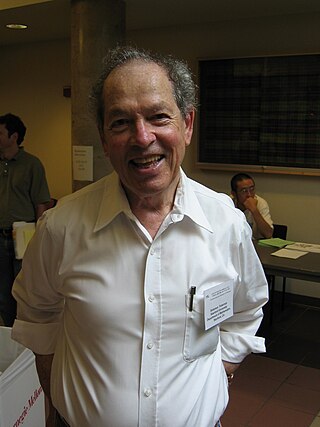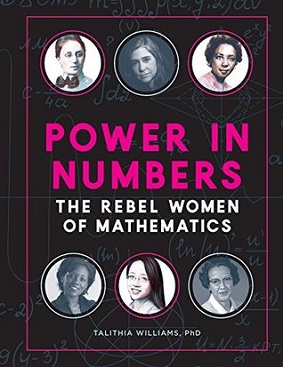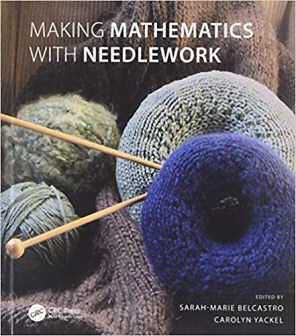
Solomon Feferman was an American philosopher and mathematician who worked in mathematical logic. In addition to his prolific technical work in proof theory, computability theory, and set theory, he was known for his contributions to the history of logic and as a vocal proponent of the philosophy of mathematics known as predicativism, notably from an anti-platonist stance.
zbMATHOpen, formerly Zentralblatt MATH, is a major reviewing service providing reviews and abstracts for articles in pure and applied mathematics, produced by the Berlin office of FIZ Karlsruhe – Leibniz Institute for Information Infrastructure GmbH. Editors are the European Mathematical Society, FIZ Karlsruhe, and the Heidelberg Academy of Sciences. zbMATH is distributed by Springer Science+Business Media. It uses the Mathematics Subject Classification codes for organising reviews by topic.

Mina Spiegel Rees was an American mathematician. She was the first female President of the American Association for the Advancement of Science (1971) and head of the mathematics department of the Office of Naval Research of the United States. Rees was a pioneer in the history of computing and helped establish funding streams and institutional infrastructure for research. Rees was also the founding president and president emerita of the Graduate School and University Center at CUNY. She received the Public Welfare Medal, the highest honor of the National Academy of Sciences; the King's Medal for Service in the Cause of Freedom (UK) and at least 18 honorary doctorates.

Margaret H. Wright is an American computer scientist and mathematician. She is a Silver Professor of Computer Science and former Chair of the Computer Science department at Courant Institute of Mathematical Sciences, New York University, with research interests in optimization, linear algebra, and scientific computing. She was elected to the National Academy of Engineering in 1997 for development of numerical optimization algorithms and for leadership in the applied mathematics community. She was elected to the National Academy of Sciences in 2005. She was the first woman to serve as President of the Society for Industrial and Applied Mathematics.
Erica Flapan is an American mathematician, the Lingurn H. Burkhead Professor of Mathematics at Pomona College. She is the aunt of sociologist Heather Schoenfeld
Laura Guggenbühl was an American mathematician, one of the earliest women in the U.S. to earn a Ph.D. in mathematics, known for her work in triangle geometry and the history of mathematics.
Judith (Judy) Green is an American logician and historian of mathematics who studies women in mathematics. She is a founding member of the Association for Women in Mathematics; she has also served as its vice president, and as the vice president of the American Association of University Professors.
Alice Jeanne LaDuke is an American mathematician who specialized in mathematical analysis and the history of mathematics. She was also a child actress who appeared in one film.
Amy Shell-Gellasch is a mathematician, historian of mathematics, and book author. She has written or edited the books
Anita Burdman Feferman was an American historian of mathematics and biographer, known for her biographies of Jean van Heijenoort and of Alfred Tarski.
The Mathematical Coloring Book: Mathematics of Coloring and the Colorful Life of Its Creators is a book on graph coloring, Ramsey theory, and the history of development of these areas, concentrating in particular on the Hadwiger–Nelson problem and on the biography of Bartel Leendert van der Waerden. It was written by Alexander Soifer and published by Springer-Verlag in 2009 (ISBN 978-0-387-74640-1).
Complexities: Women in Mathematics is an edited volume on women in mathematics that "contains the stories and insights of more than eighty female mathematicians". It was edited by Bettye Anne Case and Anne M. Leggett, based on a collection of material from the Newsletter of the Association for Women in Mathematics, and published by Princeton University Press in 2005 (ISBN 0-691-11462-5).
Peggy Aldrich Kidwell is an American historian of science, the curator of medicine and science at the National Museum of American History.

In Pursuit of the Traveling Salesman: Mathematics at the Limits of Computation is a book on the travelling salesman problem, by William J. Cook, published in 2011 by the Princeton University Press, with a paperback reprint in 2014. The Basic Library List Committee of the Mathematical Association of America has suggested its inclusion in undergraduate mathematics libraries.

Power in Numbers: The Rebel Women of Mathematics is a book on women in mathematics, by Talithia Williams. It was published in 2018 by Race Point Publishing.

Making Mathematics with Needlework: Ten Papers and Ten Projects is an edited volume on mathematics and fiber arts. It was edited by Sarah-Marie Belcastro and Carolyn Yackel, and published in 2008 by A K Peters, based on a meeting held in 2005 in Atlanta by the American Mathematical Society.
Mathematics in India: 500 BCE–1800 CE is a monograph about the history of Indian mathematics. It was written by American historian of mathematics Kim Plofker, and published in 2009 by the Princeton University Press. The Basic Library List Committee of the Mathematical Association of America has classified the book as essential for undergraduate mathematics libraries, their highest rating.
Combinatorics: The Rota Way is a mathematics textbook on algebraic combinatorics, based on the lectures and lecture notes of Gian-Carlo Rota in his courses at the Massachusetts Institute of Technology. It was put into book form by Joseph P. S. Kung and Catherine Yan, two of Rota's students, and published in 2009 by the Cambridge University Press in their Cambridge Mathematical Library book series, listing Kung, Rota, and Yan as its authors. The Basic Library List Committee of the Mathematical Association of America has suggested its inclusion in undergraduate mathematics libraries.
The Symmetries of Things is a book on mathematical symmetry and the symmetries of geometric objects, aimed at audiences of multiple levels. It was written over the course of many years by John Horton Conway, Heidi Burgiel, and Chaim Goodman-Strauss, and published in 2008 by A K Peters. Its critical reception was mixed, with some reviewers praising it for its accessible and thorough approach to its material and for its many inspiring illustrations, and others complaining about its inconsistent level of difficulty, overuse of neologisms, failure to adequately cite prior work, and technical errors.
Math on Trial: How Numbers Get Used and Abused in the Courtroom is a book on mathematical and statistical reasoning in legal argumentation, for a popular audience. It was written by American mathematician Leila Schneps and her daughter, French mathematics educator Coralie Colmez, and published in 2013 by Basic Books.






